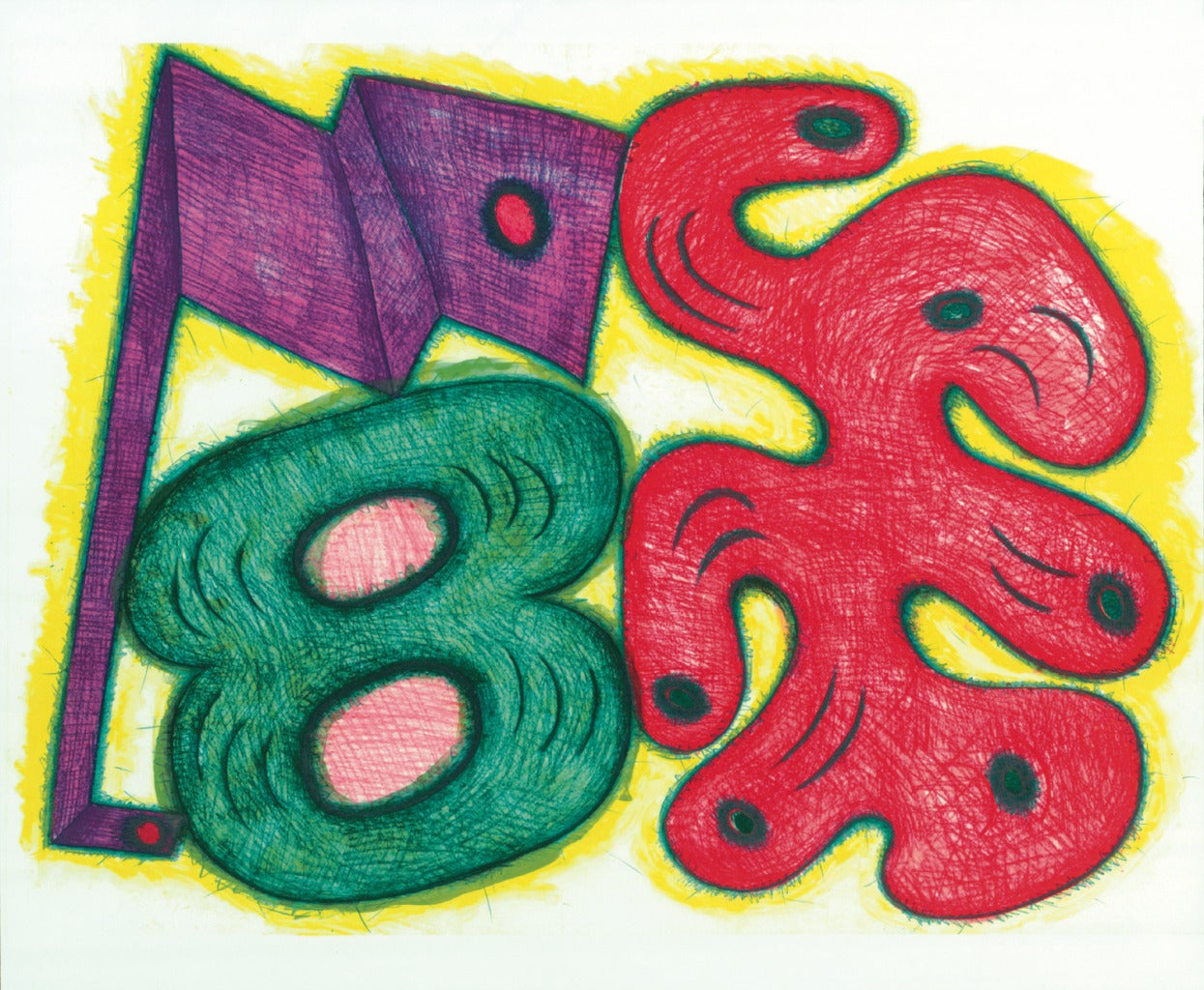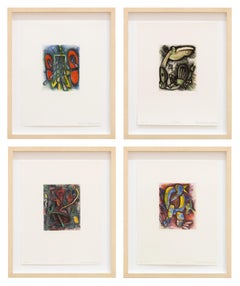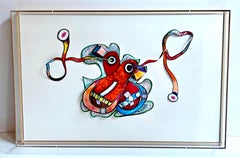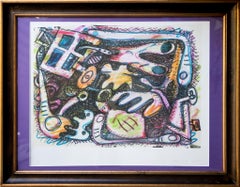Questions & Answers
Our trusted network of 1stDibs sellers answer common questions
What is Elizabeth Murray known for?
1 Answer

Elizabeth Murray, an American painter born in 1940, is best known for breaking with the tradition of two-dimensional painting, creating dimensional pieces that jut out from the wall. Her work often depicts everyday objects, like cups, tables and utensils, embellished with cartoonish body parts. Shop a selection of Elizabeth Murray artwork from some of the world’s top art dealers on 1stDibs.
1stDibs ExpertApril 5, 2022
Related Questions
- What happened to Elizabeth Arden?1 Answer
- Is Elizabeth Arden a good brand?1 Answer
- How did Elizabeth Catlett make her prints?1 Answer
- What happened to the Elizabeth and James brand?1 Answer
- What color was Queen Elizabeth's wedding dress?1 Answer
Shop for Elizabeth Murray Art on 1stDibs
Quartet
By Elizabeth Murray
Located in Austin, TX
Set of four etching and aquatints on Arches En Tout Cas paper and Fabriano Esportazione paper
Publishes bt Universal Limited Art Editions, West Islip, New York.
Printed by John Lun...
Category
Late 20th Century Abstract Prints and Multiples
Materials
Etching, Aquatint
Crossing (Gemini 1776) Unique signed hand-colored paper assemblage with collage
By Elizabeth Murray
Located in New York, NY
Elizabeth Murray
Crossing, 1999
Unique hand-colored paper assemblage with collage on Rives BFK on white Rising 4-ply museum support board
Signed and dated in pencil
19 1/2 × 30 × 4 inches
Framed: held in acrylic shadow box frame
Unique hand-colored paper assemblage with collage on Rives BFK on white Rising 4-ply museum board support, signed and dated in pencil. This mixed media paper construction with hand coloring is housed in an acrylic box shadow frame, part of the "Crossing Series" of 33 works, each entirely unique, published by Gemini G.E.L.,
Catalogue Reference: Gemini 1776
Provenance: the Family Collection of Harry W. and Mary M. Anderson
Artist Biography:
Elizabeth Murray (b. 1940, Chicago, IL—d. 2007, Granville, NY) was an artist at the forefront of American painting for five decades and is considered one of the most important postmodern abstract artists of her time. Her drive and determination produced a singularly innovative body of work characterized by a Cubist-informed Minimalism and streetwise Surrealism. Throughout her career, she reveled in the physicality of paint and approached her work through the constructive vocabulary of sculpture, warping, twisting, splintering, and knotting her canvases. In her innovative and deeply imaginative body of work, Murray not only reclaimed the medium of paint as her own but shared personal evocations of birth and death, laughter and confusion, fullness and loss.
From an early age, Murray wanted to be an artist—a cartoonist actually. With the support of her high-school art teacher, Elizabeth Stein, Murray enrolled at the School of the Art Institute of Chicago with the aim of becoming a commercial artist. However, she would spend more time learning from the works on view in the museum than in the classroom, gravitating toward the paintings of El Greco, Francisco de Zurbarán, Georges Seurat, Henri Matisse, and Pablo Picasso. Above all, it was the work of Paul Cézanne and Willem de Kooning that fueled her commitment to becoming a painter. After graduating in 1962, she went on to continue her studies at Mills College in Oakland, California. In 1967, she moved to New York City, where she would live and work until her death in 2007.
Murray’s works from the 1960s reflect an irreverent embrace of the materiality of paint. Here, the artist experimented with elements of sculpture while maintaining allusions to the figure informed by her long-standing affinity for cartooning. Murray’s childhood love of Walt Disney and comics would underpin many aspects of her art throughout her career. During the 1970s, Murray dismantled—then rebuilt—many of the compositional strategies and theories associated with Minimalism. Using curved lines and complex shapes loosely informed by mathematical ideas, she introduced geometries that transform scale, shape, and form to her thickly painted and layered compositions. In the following decade, Murray introduced three-dimensionality to her canvases, bringing about a complete break from traditional, flat, rectilinear compositions. Muddied, moody, and gestural, the paintings of the 1980s blazed a course of international recognition and notoriety. In these works, interiors, tables, coffee cups, shoes, and other signature themes emerge from skeins of spray paint and graffiti-like markings. During the 1990s, Murray’s works became flatter while retaining a high degree of compositional elaboration and chromatic exuberance. In the final years of her career, the artist offered new visions of her characteristic motifs in vibrantly painted, multipaneled paintings.
Throughout her stellar career, Murray was a much sought-after instructor, visiting artist, and lecturer. Appointments include instructor at Rosary Hill College (1965–67), visiting artist at Wayne State University and the School of the Art Institute of Chicago (1973), instructor at Bard College (1974–77), visiting instructor at California Institute of the Arts (1975–76), lecturer at Princeton University (1977), instructor at Yale University (1977–80), instructor at School of Visual Arts in New York (1978–80), lecturer at Skowhegan School of Painting and Sculpture (1979, 1985, and 1992), lecturer at Maryland Institute College of Art (1981), lecturer at New York Studio School of Drawing, Painting and Sculpture (1987), guest curator of Artist’s Choice: Elizabeth Murray at The Museum of Modern Art, New York (1995), visiting professor of studio arts at Bard College (1999–2003), and instructor at Brooklyn College (2003–07).
Murray received numerous honors in recognition of her work, including the Walter M. Campana Award from The Art Institute of Chicago (1982), an award from American Academy of Arts and Letters (1984), Medal for Painting from Skowhegan School of Painting and Sculpture (1986), an honorary doctorate from School of the Art Institute of Chicago (1992), induction as an elected member of the American Academy of Arts and Letters, New York (1992), Larry Aldrich Award (1993), an honorary degree from Rhode Island School of Design (1993), MacArthur Fellowship (1999), an honorary doctorate from The New School (2001), National Artist Award from Anderson Ranch Art Center (2002), Distinguished Artist Award for Lifetime Achievement from College Art Association (2007), and an award from CITYarts (2007).
Significant public commissions include two New York City Transit mural projects: Blooming (1996) at Lexington Avenue/59th Street and Stream (2001) at 23rd Street/Ely Avenue.
Monographic institutional presentations include Elizabeth Murray: Drawings 1980–1986 at Carnegie Mellon University Art Gallery (1986), Elizabeth Murray: Paintings and Drawings at Dallas Museum of Art (1987, traveled to List Visual Arts Center at MIT; Museum of Fine Arts, Boston; Museum of Contemporary Art, Los Angeles; Des Moines Art Center; Walker Art Center; and Whitney Museum of American Art), Elizabeth Murray: New Work at San Francisco Museum of Modern Art (1988), Elizabeth Murray Prints: 1979–1990 at Barbara Krakow Gallery (1990, traveled to Bates College Museum of Art, David Winton Bell Gallery at Brown University, Davison Art Center at Wesleyan University, and Florida Gulf Coast Art Center), Elizabeth Murray: Recent Work at Wexner Center for the Arts at The Ohio State University (1991), Elizabeth Murray at Nerman Museum of Contemporary Art at Johnson County Community College (1993), and Elizabeth Murray: Works on Paper, Virginia Commonwealth University (1998).
In 2005, Murray earned the distinction of becoming only the fifth woman to receive a career retrospective at The Museum of Modern Art, New York, following Louise Bourgeois, Lee Krasner, Helen Frankenthaler, and Jackie Winsor...
Category
1990s Abstract Abstract Drawings and Watercolors
Materials
Paper, Mixed Media, Acrylic
"Untitled Abstract" Art Colorful Graphic Black Pink Orange Purple Blue Pop Art
By Elizabeth Murray
Located in Austin, TX
Unframed: 27.75" x 34.38"
Framed: 35.5" x 45.5"
Edition 42 of 100
Medium: Lithograph
Signed: Left Right, Elizabeth Murray
"From the Doctors of the World Portfolio"
Elizabeth Murray...
Category
21st Century and Contemporary Pop Art Abstract Prints
Materials
Digital Pigment
The Clock, Elizabeth Murray
By Elizabeth Murray
Located in New York, NY
Elizabeth Murray reshaped Modernist abstraction into a high-spirited, cartoon-based, language of form whose subjects included domestic life, relationships and the nature of painting ...
Category
20th Century Prints and Multiples
Materials
Screen
The Clock
By Elizabeth Murray
Located in New York, NY
A very good impression of this color screenprint on Coventry Rag paper. Signed, dated and numbered 2/108 in pencil. Published by The Lincoln Center/List Print Program, New York.
Category
1990s Contemporary Abstract Prints
Materials
Color, Screen
Abstract Expressionist Print by Elizabeth Murray
By Elizabeth Murray
Located in Long Island City, NY
Artist: Elizabeth Murray, American (1940 - 2007)
Title: Untitled from Doctor's of the World
Year: 2001
Edition: 24/100
Medium: Pigmented Digital Print, signed, numbered, and dated in...
Category
Early 2000s Abstract Expressionist Abstract Prints
Materials
Digital, Digital Pigment


